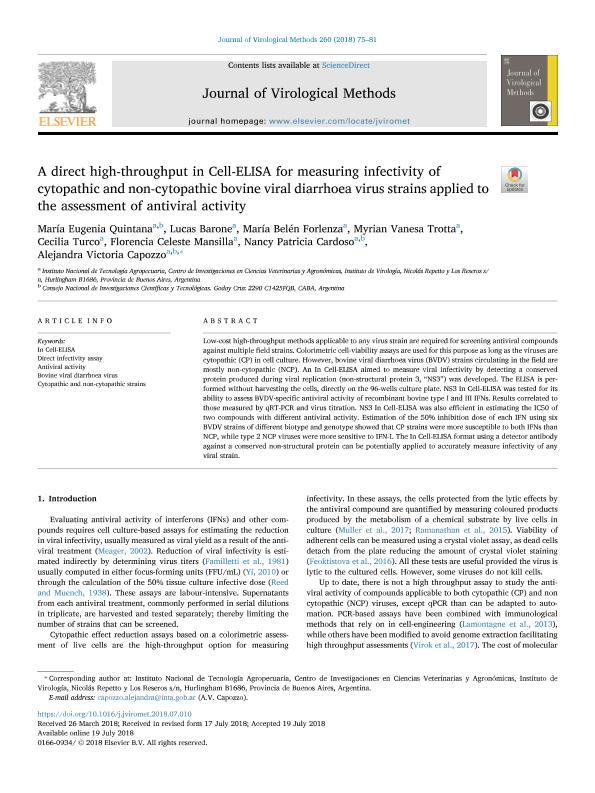Mostrar el registro sencillo del ítem
dc.contributor.author
Quintana, Maria Eugenia

dc.contributor.author
Barone, Lucas José

dc.contributor.author
Forlenza, María Belén

dc.contributor.author
Trotta, Myrian Vanesa

dc.contributor.author
Turco, Cecilia Soledad

dc.contributor.author
Mansilla, Florencia Celeste

dc.contributor.author
Cardoso, Nancy Patricia

dc.contributor.author
Capozzo, Alejandra Victoria

dc.date.available
2020-02-21T19:25:49Z
dc.date.issued
2018-10
dc.identifier.citation
Quintana, Maria Eugenia; Barone, Lucas José; Forlenza, María Belén; Trotta, Myrian Vanesa; Turco, Cecilia Soledad; et al.; A direct high-throughput in Cell-ELISA for measuring infectivity of cytopathic and non-cytopathic bovine viral diarrhoea virus strains applied to the assessment of antiviral activity; Elsevier Science; Journal of Virological Methods; 260; 10-2018; 75-81
dc.identifier.issn
0166-0934
dc.identifier.uri
http://hdl.handle.net/11336/98318
dc.description.abstract
Low-cost high-throughput methods applicable to any virus strain are required for screening antiviral compounds against multiple field strains. Colorimetric cell-viability assays are used for this purpose as long as the viruses are cytopathic (CP) in cell culture. However, bovine viral diarrhoea virus (BVDV) strains circulating in the field are mostly non-cytopathic (NCP). An In Cell-ELISA aimed to measure viral infectivity by detecting a conserved protein produced during viral replication (non-structural protein 3, “NS3”) was developed. The ELISA is performed without harvesting the cells, directly on the 96-wells culture plate. NS3 In Cell-ELISA was tested for its ability to assess BVDV-specific antiviral activity of recombinant bovine type I and III IFNs. Results correlated to those measured by qRT-PCR and virus titration. NS3 In Cell-ELISA was also efficient in estimating the IC50 of two compounds with different antiviral activity. Estimation of the 50% inhibition dose of each IFN using six BVDV strains of different biotype and genotype showed that CP strains were more susceptible to both IFNs than NCP, while type 2 NCP viruses were more sensitive to IFN-I. The In Cell-ELISA format using a detector antibody against a conserved non-structural protein can be potentially applied to accurately measure infectivity of any viral strain.
dc.format
application/pdf
dc.language.iso
eng
dc.publisher
Elsevier Science

dc.rights
info:eu-repo/semantics/openAccess
dc.rights.uri
https://creativecommons.org/licenses/by-nc-sa/2.5/ar/
dc.subject
ANTIVIRAL ACTIVITY
dc.subject
BOVINE VIRAL DIARRHOEA VIRUS
dc.subject
CYTOPATHIC AND NON-CYTOPATHIC STRAINS
dc.subject
DIRECT INFECTIVITY ASSAY
dc.subject
IN CELL-ELISA
dc.subject.classification
Otras Ciencias Veterinarias

dc.subject.classification
Ciencias Veterinarias

dc.subject.classification
CIENCIAS AGRÍCOLAS

dc.title
A direct high-throughput in Cell-ELISA for measuring infectivity of cytopathic and non-cytopathic bovine viral diarrhoea virus strains applied to the assessment of antiviral activity
dc.type
info:eu-repo/semantics/article
dc.type
info:ar-repo/semantics/artículo
dc.type
info:eu-repo/semantics/publishedVersion
dc.date.updated
2020-02-18T16:07:04Z
dc.journal.volume
260
dc.journal.pagination
75-81
dc.journal.pais
Países Bajos

dc.journal.ciudad
Amsterdam
dc.description.fil
Fil: Quintana, Maria Eugenia. Consejo Nacional de Investigaciones Científicas y Técnicas; Argentina. Instituto Nacional de Tecnología Agropecuaria. Centro de Investigación en Ciencias Veterinarias y Agronómicas. Instituto de Virología; Argentina
dc.description.fil
Fil: Barone, Lucas José. Consejo Nacional de Investigaciones Científicas y Técnicas; Argentina. Instituto Nacional de Tecnología Agropecuaria. Centro de Investigación en Ciencias Veterinarias y Agronómicas. Instituto de Virología; Argentina
dc.description.fil
Fil: Forlenza, María Belén. Instituto Nacional de Tecnología Agropecuaria. Centro de Investigación en Ciencias Veterinarias y Agronómicas. Instituto de Virología; Argentina. Consejo Nacional de Investigaciones Científicas y Técnicas; Argentina
dc.description.fil
Fil: Trotta, Myrian Vanesa. Instituto Nacional de Tecnología Agropecuaria. Centro de Investigación en Ciencias Veterinarias y Agronómicas. Instituto de Virología; Argentina. Consejo Nacional de Investigaciones Científicas y Técnicas; Argentina
dc.description.fil
Fil: Turco, Cecilia Soledad. Instituto Nacional de Tecnología Agropecuaria. Centro de Investigación en Ciencias Veterinarias y Agronómicas. Instituto de Virología; Argentina. Consejo Nacional de Investigaciones Científicas y Técnicas; Argentina
dc.description.fil
Fil: Mansilla, Florencia Celeste. Instituto Nacional de Tecnología Agropecuaria. Centro de Investigación en Ciencias Veterinarias y Agronómicas. Instituto de Virología; Argentina. Consejo Nacional de Investigaciones Científicas y Técnicas; Argentina
dc.description.fil
Fil: Cardoso, Nancy Patricia. Instituto Nacional de Tecnología Agropecuaria. Centro de Investigación en Ciencias Veterinarias y Agronómicas. Instituto de Virología; Argentina. Consejo Nacional de Investigaciones Científicas y Técnicas; Argentina
dc.description.fil
Fil: Capozzo, Alejandra Victoria. Instituto Nacional de Tecnología Agropecuaria. Centro de Investigación en Ciencias Veterinarias y Agronómicas. Instituto de Virología; Argentina. Consejo Nacional de Investigaciones Científicas y Técnicas; Argentina
dc.journal.title
Journal of Virological Methods

dc.relation.alternativeid
info:eu-repo/semantics/altIdentifier/url/sciencedirect.com/science/article/pii/S0166093418301617
dc.relation.alternativeid
info:eu-repo/semantics/altIdentifier/doi/http://dx.doi.org/10.1016/j.jviromet.2018.07.010
Archivos asociados
